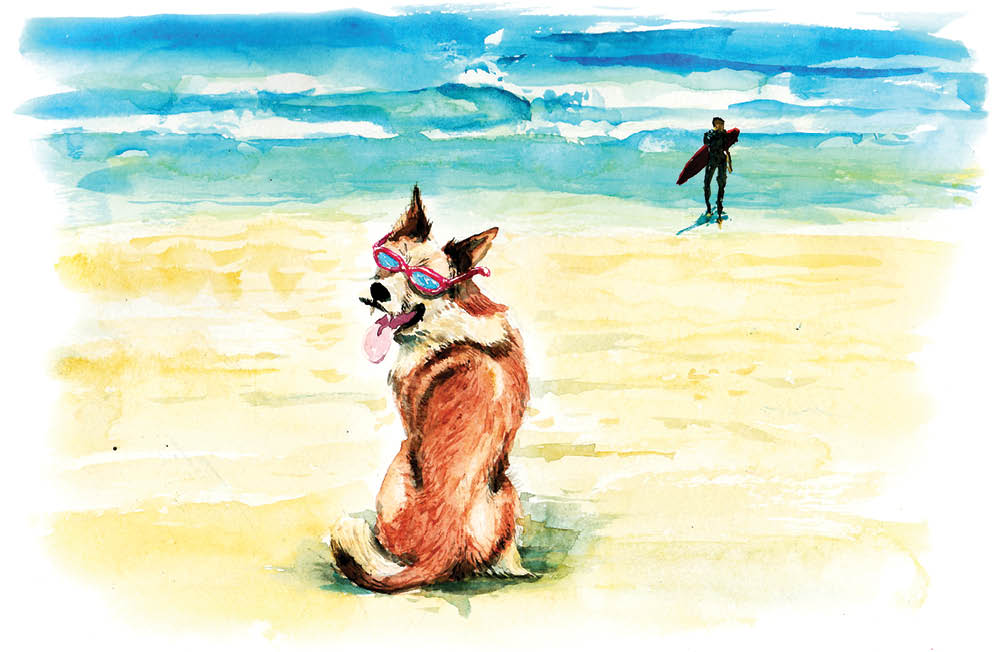The Short History Of The Surf Mutt
Share
Had a dog once. Big fat happy Labrador called Harry. He’d run down the beach and find something dead, then we’d have a standoff about whether it was coming home with him in the car. I drew the line at birds: he didn’t. One day he picked up a dead penguin, its little flippers hanging mournfully from the sides of his dribbling gob. I had to chase him around the car park, red-faced with fury. A tourist bus rolled up, the horrified occupants pointing their cameras and making disapproving cat’s bum shapes with their mouths, until I found myself yelling at the windows “HE DIDN’T KILL IT, OKAY?”
Same dog once found a rotting seal and rolled joyfully in the sticky pool of decomposing mammal while I fled into the water. A hundred metres off the rockshelf, the bloody dog appears beside me, grinning like a fool and leaving a slick of putrescent seal goo. Fat dog marinated in dead seal. Sharks as far away as South Africa dropped everything: What IS that smell?
Dogs are probably the most useful accessory in surfing. Fierce ones to guard your stuff. Cute ones to facilitate introductions with interesting humans (“Oh there he is. You little scamp!”). Intelligent ones to make conversation on road trips and do that flapping jowl thing with the window down. Dumb ones you can tell off when you need to act tough.
A wet dog is possessed of an uncanny instinct for the shake-out. They will hover, dripping, while your anxiety mounts. They circle, eyes rolled back to show the whites. Gamesmanship. Then they pounce, whirling that shaggy coat full of seawater, sand and dog smell all over the least interested bystander. Then they bolt, leaving a dog-shaped dry spot on the ground, framed in fallen droplets.
When asked to explain the title of his mad and majestic album Rain Dogs, Tom Waits said, “You know how after the rain you see all these dogs that seem lost, wandering around. The rain washes away all their scent, all their direction.” A similar thing happens to the surf dog waiting on the beach. Some sit, magically tethered to the sand by their obedience but twitching furiously. Some bolt around with sand on their snouts. All of them pine for the return of their masters, who for some reason pulled on a rubber suit and jumped into the ocean. Each surfer who emerges from the water is greeted by the dog with leaps of joy: the human is washed clean of scent, and the poor mutt is unable to distinguish one from another until they’re at close quarters and the body language is wrong, the dimensions different. They visibly slump with disappointment. This one’s not mine.
In John Witzig’s iconic portrait of his brother Paul at Cactus in the 70s, there are no fewer than three dogs in the frame. You don’t notice them (partially because of Paul’s outrageously stylish boiler suit), because that’s how it’s always been with surf dogs: ever there, faithful and close, but never clamouring for the limelight.
The hundreds of photos online of dogs surfing are further proof that the whole lot of ’em would rather be backstage eating the aforementioned dead penguin. Dogs are quadrupeds. They can stand on a board but they can‘t surf. They can’t spread their arms to impart balance and style, so the anthropomorphic effect desired by the photographer invariably fails – the animal just looks like it’s clinging on for dear life. And no, putting Cujo in a pair of sunnies or a little cutesy Hawaiian shirt does not rectify the problem.
